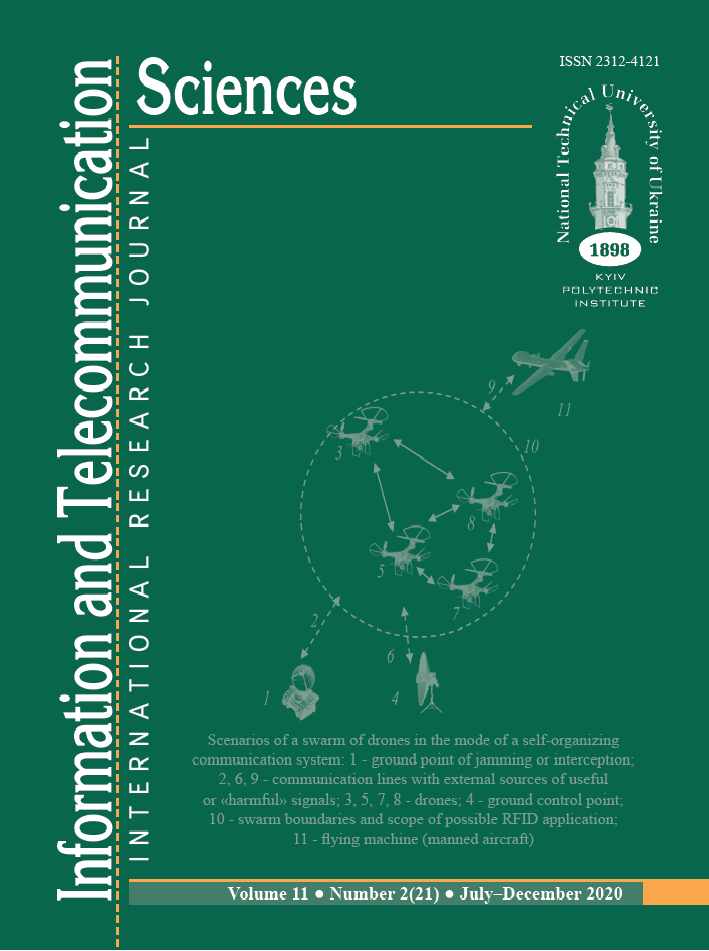INFLUENCE OF DOPPLER EFFECTS ON 2×2 TO 4×4 MIMO SYSTEMS WITH DIRECT LINE-OF-SIGHT PATH BY RICIAN FADING DISTRIBUTION
DOI:
https://doi.org/10.20535/2411-2976.22020.5-15Keywords:
wireless communication system, MIMO, Rician fading, channel state estimation, orthogonal pilot sequences, Doppler effect.Abstract
Background. For multiplying the capacity of a radio link by using multiple antennas at the transmitter and receiver ends, wireless communication networks use the MIMO technique. The quality of MIMO wireless communication may worsen when either the transmitter or receiver end is in motion, or they both are in motion. To sustain high quality of links, MIMO operates, in particular, on channel state information by using orthogonal pilot sequences.
Objective. The goal is to estimate the bit-error-rate performance of 2×2, 3×3, and 4×4 MIMO systems with orthogonal pilot sequences for a range of Doppler shifts by the Rician fading distribution modeling the scenario of direct line-of-sight path. The estimation is believed to answer the question on MIMO efficiency by ascertaining whether increasing the number of antennas mitigates the Doppler effect in 2×2 to 4×4 MIMO systems with direct line-of-sight path.
Methods. To achieve the goal, 2×2 to 4×4 MIMO systems with channel state estimation are simulated. The simulation is configured and carried out by using MATLAB® R2019a Communications System ToolboxTM functions. The 35 subcases of the frame length and number of pilot symbols per frame are considered.
Results. The near-exponential-type decreasing of the bit-error-rate performance is almost not violated by no motion, whereas further speed increments destroy it for 2×2 MIMO systems. It is revealed that too long packet transmissions by short orthogonal pilot sequences (with respect to the packet length) are prone to errors. This especially concerns 2×2 MIMO systems, where channel state estimation by short orthogonal pilot sequences appears to be ineffective or weakly effective.
Conclusions. In general, to maintain an appropriate MIMO link data rate, the packet length should be shortened as the motion speed increases. Increasing the number of antennas additionally mitigates Doppler effects. S o, 4 ×4 M IMO s ystem transmissions are indeed efficient. The shortest possible packet transmissions are not affected by Doppler effects if three or four antennas are used.
References
BergerL. T. et al., MIMO Power Line Communications: Narrow and Broadband Standards, EMC, and Advanced Processing. Devices, Circuits, and Systems. 2014, CRC Press, 710 p. https://doi.org/10.1201/b16540
Pätzold M., Mobile Fading Channels. 2002, Wiley, 418 p. https://doi.org/10.1002/0470847808
Skolnik M., Introduction to Radar Systems. 3rd Ed. 2001, McGraw-Hill, New York, 772 p.
Stern H.and Mahmoud S., Communication Systems: Analysis and Design. 2004, Pearson Prentice Hall, 530 p.
Le K. N., “A review of selection combining receivers over correlated Rician fading”, Digital Signal Processing, 2019, vol. 88, pp. 1 — 22.
https://doi.org/10.1016/j.dsp.2019.01.015
Lee W. C. Y., Mobile Communications Engineering:
Theory and Applications. 2nd Ed. 1998, McGraw-Hill, 689 p.
Naguib A. F. et al., “Space-time codes for high data rate
wireless communication: Mismatch analysis”, Proceedings of
IEEE International Conference on Communications,
Montréal, Québec, Canada, 8 — 12 June 1997, pp. 309 —313.
Zhuang A., Lohan E. S., and Renfors M., “Comparison of decision-directed and pilot-aided algorithms for complex channel tap estimation in downlink WCDMA systems”, Proceedings of 11th IEEE Personal and Indoor Mobile Radio Communications (PIMRC), Vol. 2, London, UK, September 2000, pp. 1121 — 1125.
Tsoulos G., MIMO System Technology for Wireless
Communications. 2006, CRC Press, 400 p.
https://doi.org/10.1201/9781315222011
Han H.-D. et al, “Pilot decontamination for multi-cell
massive MIMO systems using asynchronous pilot design and
data-aided channel estimation,” Physical Communication,
, vol. 30, pp. 76 — 85.
https://doi.org/10.1016/j.phycom.2018.07.006
Walsh J. L., “A closed set of normal orthogonal
functions”, American Journal of Mathematics, 1923, vol. 45,
no. 1, pp. 5 — 24.
Romanuke V. V., “Computational method of building
orthogonal binary functions bases for multichannel
communication systems with code channels division”,
Mathematical Modeling and Computational Methods,
Ternopil State Technical University, Ternopil, Ukraine, 2006,
p.
Romanuke V. V., “Generalization of the eight known
orthonormal bases of binary functions to the eight
orthonormal bases of binary surfaces,” Optoelectronic
Information-Power Technologies, no. 2, pp. 263 — 271,
Romanuke V. V., “Simulation of code division by applying systems of orthogonal binary functions CDMA-system,” Herald of Khmelnytskyi National University. Technical sciences, 2008, no. 6, pp. 121 — 132.
Torrieri D., Principles of Spread-Spectrum Communication
Systems. 4th Ed. 2018, Springer, 727 p.
https://doi.org/10.1007/978-3-319-70569-9
Zheng L. and Tse D. N. C., “Diversity and multiplexing:
A fundamental tradeoff in multiple-antenna channels,” IEEE
Transactions on Information Theory, 2003, vol. 49, iss. 5, pp.
— 1096.
https://doi.org/10.1109/TIT.2003.810646
Sklar B., “Rayleigh fading channels in mobile digital
communication systems. Part 1: Characterization,” IEEE
Communication Magazine, 1997, vol. 35, iss. 7, pp. 90 —

